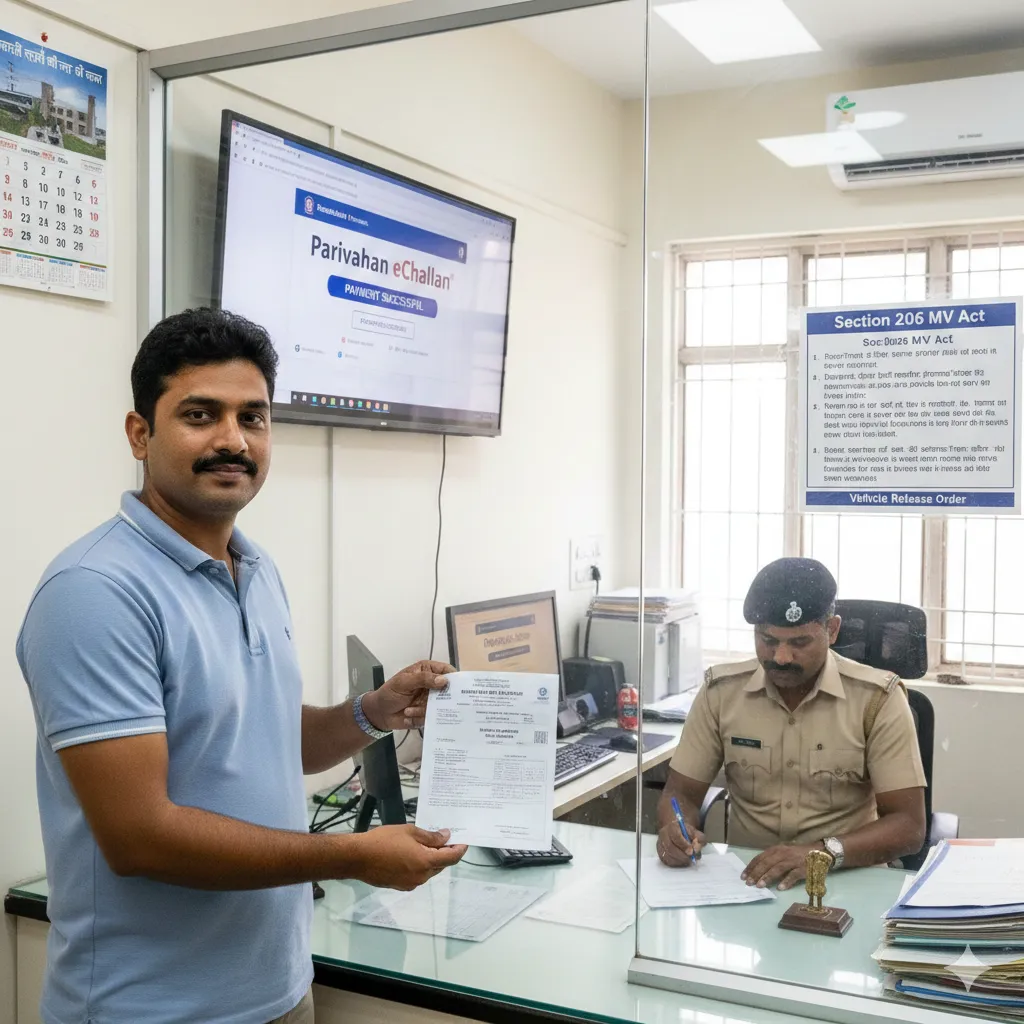Home / Motor Insurance / Articles / Traffic Rules / Legal Process to Get Your RC/DL or Vehicle Back After a Violation
Legal Process to Get Your RC/DL or Vehicle Back After a Violation
Saumya SrivastavaNov 25, 2025
Share Post
When your RC or DL is seized for a traffic violation, getting it back can feel complicated, but the process is quite straightforward once you know the steps. Start by checking the offence details, fine amount, and hearing date on the Parivahan e-challan portal. After clearing the dues, the RTO issues a document release memo.
Here is a quick guide to help you get your RC or DL back after a challan without hassle.

Contents
What is the Legally Approved RTO document Recovery Process?
Under Section 206 of the MV Act (1988), even though the police officers have the right to seize your RC or DL, the power to revoke or suspend a license lies only with the licensing authority.
If your driving license or vehicle's registration certificate is impounded by the Regional Transport Office (RTO), here is a step-by-step guide on how to get RC or DL back after a challan:
Step 1: Visit the Parivahan e-challan portal to confirm the offence, fine amount and whether the case will require a court hearing.
Step 2: If the fine is payable online, pay it immediately; otherwise, visit a local traffic police station for offline payment.
Step 3: RTO will verify the case by reviewing documents and initiate the return process.
Step 4: If the traffic violation requires your presence at court, you have to be present on that assigned date, explain your case, pay the fines and receive the release order from the court.
Step 5: After showing the release memo at the RTO or the traffic police station, you will get your RC or DL back.
How to Get Your Vehicle Back After a Violation?
If your vehicle is involved in an accident, traffic violation, or criminal violence, as per the RC confiscation rules in India, under section 207 of the Motor Vehicle Act (1988), police officers and enforcement authorities have the right to seize the vehicle.
After an up challan check confirms the details of the offence, Section 457 of the Criminal Procedure Code (CrPC) provides Magistrates with the power to release that vehicle following these steps:
Step 1: Depending on the stage of the case, vehicle owners can apply under section 451 or 457 of the CrPC.
Step 2: An applicant must attach the registration number, driving license, identity proof, and insurance papers.
Step 3: Vehicle owners sign a bond guaranteeing that, upon the court's order, they will produce their vehicles.
Step 4: After filing, a hearing is scheduled.
Step 5: On the hearing date, a lawyer presents the case to the Magistrate and the prosecution.
Step 6: After verifying documents, conducting case hearings, and presenting evidence, the Magistrate issues a release order.
Step 7: Once the vehicle owner produces a release order to the police station, the vehicle is released.
Step 8: If the Magistrate denies a release order, the offender can appeal the decision and approach the Sessions court or the High Court under section 482 of the CrPC to obtain release of their vehicle.
Important Tips to Speed Up the RTO Document Recovery Process
The following tips can help in speeding up the RTO document recovery process:
Carry digital copies of your driving license (DL), vehicle’s registration certificate (RC), pollution certificate (PUC), and insurance policy documents at all times.
Check and respond to traffic challans as soon as possible.
Until the court officially releases your vehicle, it is best to avoid driving it.
When served with a court summons, try to arrive on time to avoid having your date rescheduled.
Final Thoughts
The process of getting an RC or DL back after a challan is quite straightforward. However, after a vehicle is seized due to involvement in traffic violations or a criminal offence, owners must go through a standard court procedure to have it released. It involves going to the Magistrate and signing a bond. If you know what to expect, it becomes less frustrating. Cooperating with the authorities ensures you get everything back without unnecessary hassle.
Choose ACKO to make e-challan payment smooth. Our 24/7 customer care and top-notch digital process ensure you only need a few clicks to get the work done.
Frequently Asked Questions
How to release a seized vehicle?
Firstly, owners must apply to the magistrate and sign a bond guaranteeing that their vehicle will be produced at court if and when necessary and will not hinder any court trial. After analysing the case, the magistrate will pass a release order. Traffic authorities release the vehicle after seeing the release order.
Can the Police Take My Driving License?
Yes, the police can take your driving license if they catch you violating traffic rules. However, only the licensing authority has the right to revoke or suspend a driving license.
How to get RC or DL back after a challan?
To get your RC or DL back, you must pay the fine immediately. You can do that through the Parivahan eChallan Portal or in person at a local police station or court. Once your fine is cleared, you will get your RC and DL back.

Recent
Articles
Legal Process to Get Your RC/DL or Vehicle Back After a Violation
Saumya Srivastava Nov 25, 2025
The Downside of Missing Family Health Insurance Renewals
Roocha Kanade Nov 25, 2025
Why Network Hospitals Are Crucial in Family Health Insurance
Roocha Kanade Nov 24, 2025
Combining Employer Coverage with a Family Floater Plan
Roocha Kanade Nov 20, 2025
How to Clear a Challan in Virtual Court
Saumya Srivastava Nov 20, 2025
All Articles
Want to post any comments?
Check Traffic Challans Instantly ⚡️
Enter your vehicle number
Check your challans


